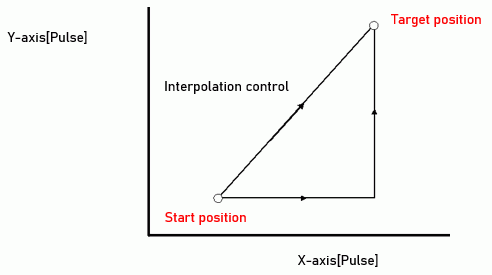
(Linear) interpolation control can be realized.
Interpolation control means that the speed of each axis can be determined once the moving distance and speed of one axis and the moving distance of the other axis are set.
This makes it possible to move the shortest distance from the start point to the target point instead of moving along the X axis and then moving along the Y axis (this is an extreme example).
Interpolation control can be easily realized by specifying interpolation operation with the operation setting function.

[Output pulse at linear interpolation]
The axis with the maximum amount of movement is automatically determined from the interpolation target axes set by the SmcWSetBankInterpolation function, and that axis is used as the main axis.
The other interpolation target axes are slave axes, and the slave axes output pulses at the timing shown in the figure below.
The leading axis of the interpolation target axes becomes the interpolation control axis.
Specify the interpolation control axis for the axis number of each operation setting function for linear interpolation (or bank linear interpolation) operation.
[Precision of linear interpolation]
Linear interpolation executes an interpolation from the current coordinates to the end coordinates.
The positional precision of a specified line during linear interpolation will be [Setting speed resolution ± 0.5] throughout the interpolation range.
One square in the figure below corresponds to the speed resolution.